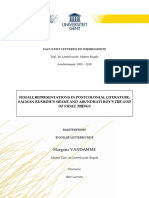Wagashi
Wagashi
Uploaded by
Bookturnal PlaceCopyright:
Available Formats
Wagashi
Wagashi
Uploaded by
Bookturnal PlaceOriginal Description:
Copyright
Available Formats
Share this document
Did you find this document useful?
Is this content inappropriate?
Copyright:
Available Formats
Wagashi
Wagashi
Uploaded by
Bookturnal PlaceCopyright:
Available Formats
Wagashi and the Japanese Tradition
of Hospitality
In the last few years, the English term sweets has come to be used in Japanese as
a hold-all term referring to all kinds of cakes and confectionary. But it seems a
shame to lump the Japanesewagashi traditionally served with tea into the same
category. They have a special role in social ritual that makes them quite different.
This spring, I took part in a round-table on the subject of traditional Japanese
confectionary culture with the proprietors and artisans of some of Kyotos oldest
traditional wagashi shops. The colors and forms of the wagashi are inspired by
motifs celebrating the beauties of nature. The artistry and attention to detail that goes
into making them is truly remarkable. The artisans who create these edible works of
art somehow manage to impart into the wagashi the very essence of the seasons
mountains, fields, rivers, and lakes. You can almost feel the wind and light of the time
of year. The artisans have an uncanny sensitivity to nature, and live in intimate
proximity with the changing seasons.
During the round table, one wagashi maker explained that Traditional wagashi are
much more than simply a sweet snack. There are part of a culture of hospitality, with
its precise etiquette and traditions. In Kyoto, the host washes down the area in front
of the house and lights incense in the entrance porch in anticipation of a visit. The
ground mustnt be either too wet or too dry when the guest arrives. If the incense is
lit too soon, the scent will have disappeared by the time the guest arrives. But if the
smoke is still rising when the guest arrives, that is a discourtesy too. Timing is
essential. The host arranges a selection of seasonal flowers, and hangs a scroll with
some kind of relevance to the season, the expected guest, or the topic to be
discussed.
Wagashi and the Aesthetics of Minimalism
When the guest arrives the host serves tea, and then it is time for the wagashi to
make their appearance. Seasonal motifs are used in the wagashi, as well as elegant
poetic names. The guest will normally start by admiring the beauty of the design, and
then ask about the name of thewagashi. This provides a topic for conversation. Many
of the names allude to lines from classical literature. Finally, the guest raises
the wagashi to her lips. First one enjoys the wagashi with the eyes. Next comes the
imaginative enjoyment of the allusions evoked by the nameonly then does one
enter the world of flavor. The wagashi is not something to be scoffed down as soon
as it appears. It is a sophisticated pleasure for mature adults, resonant with the
empty space of the Japanese minimalist aesthetic.
Cherry Blossoms Against the Sunlight
The final stage in the ritual of hospitality is the farewell. In Kyoto, it is common in
private homes and restaurants alike for the host to remain on the threshold until the
guests are out of sight. Hospitality in Japan is the crystallization of many aspects of
Japanese culture: courtesy, consideration, and respect for others, along with an
esthetic enjoyment of nature and the changing seasons, and a culture that esteems
empty space. As part of such an intricate culture of hospitality, it doesnt seem right
to refer to traditional wagashi with a common catch-all term like sweets.
One spring day almost 20 years ago, I came across a beautiful example of the
Japanese confectioners art in a traditional old shop in Kyoto. It was made of sweet
white bean paste wrapped in a soft mochi coating called gyhi. I asked about the
name. Urazakura, the owner told me. Cherry blossoms against the backlit sun. He
explained that the pink color of the confection was reminiscent of the sunlight shining
translucent through cherry blossom petals. Such subtlety and depth! In the years
passed since, I have often remembered the hidden beauty of those cherry blossoms
against the sunlight, symbol of Japanese beauty.
(Originally written in Japanese on May 8, 2013.)
You might also like
- Malaysian Chinese Food: Penang Rojak in MalaysiaDocument4 pagesMalaysian Chinese Food: Penang Rojak in MalaysiaGodknows KelvinNo ratings yet
- Eating Her Curries and Kway - A Cultural History of Food in Singapore (Nicole Tarulevicz)Document225 pagesEating Her Curries and Kway - A Cultural History of Food in Singapore (Nicole Tarulevicz)ncco rccs100% (2)
- Feasts: The 3rd Book From The Bestselling Author of Persiana, Sirocco, Bazaar and Simply - General CookeryDocument5 pagesFeasts: The 3rd Book From The Bestselling Author of Persiana, Sirocco, Bazaar and Simply - General CookerywateriniNo ratings yet
- Maldives CuisineDocument12 pagesMaldives CuisineSudipto MukherjeeNo ratings yet
- Specific Learning DisabilitiesDocument61 pagesSpecific Learning DisabilitiesCera MonikaNo ratings yet
- MR NobodyDocument4 pagesMR NobodyIva SivarajaNo ratings yet
- Wagashi - Jo-Namagashi - Nerikiri RecipeDocument9 pagesWagashi - Jo-Namagashi - Nerikiri RecipeDavid100% (1)
- Hints For The Table PDFDocument204 pagesHints For The Table PDFSantiago Gutierrez100% (1)
- Integated Final Report - Bak Kut TehDocument45 pagesIntegated Final Report - Bak Kut Tehapi-289044943No ratings yet
- Thousand Slices Turnips Recipe From Asian Pickles Japan by Karen SolomonDocument11 pagesThousand Slices Turnips Recipe From Asian Pickles Japan by Karen SolomonThe Recipe Club50% (2)
- Simple Chinese Cookbook - Art and Recipes from China even for BeginnersFrom EverandSimple Chinese Cookbook - Art and Recipes from China even for BeginnersNo ratings yet
- French Cuisine. Century by AUGUSTE ESCOFFIER To Become The Modern Version of Haute CuisineDocument5 pagesFrench Cuisine. Century by AUGUSTE ESCOFFIER To Become The Modern Version of Haute CuisineAnkit TrivediNo ratings yet
- World Tour of The Best SandwichesDocument80 pagesWorld Tour of The Best SandwichesLuiz Henrique Bastos Junior100% (1)
- Tsukemono - A Selection of Pickled JapanDocument9 pagesTsukemono - A Selection of Pickled JapanHandri HuangNo ratings yet
- Japanese Cuisine - FinalDocument43 pagesJapanese Cuisine - Finaldennis artugue100% (2)
- The Italian Art of CuisineDocument256 pagesThe Italian Art of CuisinetyldermineNo ratings yet
- Excerpt and Recipes From Kibo by Elizabeth AndohDocument25 pagesExcerpt and Recipes From Kibo by Elizabeth AndohThe Recipe Club83% (6)
- Wagashi (Japanese Bean Sweets) : Prep Time: Cook Time: Kitchen ToolsDocument1 pageWagashi (Japanese Bean Sweets) : Prep Time: Cook Time: Kitchen ToolsSaskia SmitNo ratings yet
- Protein Stabilized EmulsionsDocument9 pagesProtein Stabilized EmulsionsRayito HernándezNo ratings yet
- The Guardian Feast-14 January 2023Document24 pagesThe Guardian Feast-14 January 2023Pepito conguito100% (1)
- Amma's Cuisine: Traditional Sri Lankan & International Recipes and Island Wedding StoryFrom EverandAmma's Cuisine: Traditional Sri Lankan & International Recipes and Island Wedding StoryNo ratings yet
- Sushi Training ManualDocument49 pagesSushi Training Manualalangchannell01No ratings yet
- The Science of Fluid Gels - ChefStepsDocument8 pagesThe Science of Fluid Gels - ChefStepsGABRIEL VIVASNo ratings yet
- 食用花卉:全球历史Document127 pages食用花卉:全球历史17621415996No ratings yet
- VEGAN CHINA: Delicious and Wholesome Plant-Based Chinese Recipes for a Healthier YouFrom EverandVEGAN CHINA: Delicious and Wholesome Plant-Based Chinese Recipes for a Healthier YouNo ratings yet
- Excerpt From My Perfect Pantry by Geoffrey ZakarianDocument12 pagesExcerpt From My Perfect Pantry by Geoffrey ZakarianThe Recipe ClubNo ratings yet
- Food of MoroccoDocument271 pagesFood of Moroccoamine50% (2)
- KojiAlchemy IntroductionDocument12 pagesKojiAlchemy IntroductionChelsea Green Publishing100% (1)
- Vegan Burger Menu PDFDocument2 pagesVegan Burger Menu PDFjoanne_rawksNo ratings yet
- A Taste of Spain 100 Favourites - Randolph Riecker PDFDocument182 pagesA Taste of Spain 100 Favourites - Randolph Riecker PDFNoli Sta Teresa100% (1)
- Food Culture in BelgiumDocument261 pagesFood Culture in BelgiumclaudioNo ratings yet
- Chez Panisse Desserts - Shere, Lindsey Remolif, 1935 - 1st Ed., New York, 1985 - New York - Random House - 9780394538600 - Anna's ArchiveDocument360 pagesChez Panisse Desserts - Shere, Lindsey Remolif, 1935 - 1st Ed., New York, 1985 - New York - Random House - 9780394538600 - Anna's ArchiveDenis sineNo ratings yet
- Washoku PDFDocument36 pagesWashoku PDFRyan O'Coffey100% (2)
- Korean Cooking For Indian HomesDocument17 pagesKorean Cooking For Indian Homessadhana100% (1)
- Xenia - Chef Competition QuizDocument319 pagesXenia - Chef Competition QuizAbhishek GowdaNo ratings yet
- Salads, Sandwiches 1Document178 pagesSalads, Sandwiches 1Gutenberg.orgNo ratings yet
- Recipes From Lucid Food by Louisa ShafiaDocument11 pagesRecipes From Lucid Food by Louisa ShafiaThe Recipe Club67% (3)
- Osteria - Rick TramontoDocument288 pagesOsteria - Rick Tramontosteven delucaNo ratings yet
- Let’s Make Sushi!: Step-by-Step Tutorials and Essential Recipes for Rolls, Nigiri, Sashimi and More from a Master Sushi ChefFrom EverandLet’s Make Sushi!: Step-by-Step Tutorials and Essential Recipes for Rolls, Nigiri, Sashimi and More from a Master Sushi ChefNo ratings yet
- The Essential Tequila & Mezcal Companion: How to Select, Collect & Savor Agave SpiritsFrom EverandThe Essential Tequila & Mezcal Companion: How to Select, Collect & Savor Agave SpiritsNo ratings yet
- Cocina JaponesaDocument240 pagesCocina JaponesaKarina ONo ratings yet
- Offals Lesson 6Document20 pagesOffals Lesson 6Timothy muthamiaNo ratings yet
- Japanese CuisineDocument5 pagesJapanese CuisineTrisha May SalvadorNo ratings yet
- NoMU Recipe Mailer Vol52 Feb10Document4 pagesNoMU Recipe Mailer Vol52 Feb10penceaNo ratings yet
- Sushi 101: The Ultimate Sushi Cheat Sheet For Beginners: Home BlogDocument13 pagesSushi 101: The Ultimate Sushi Cheat Sheet For Beginners: Home BlogArben MontellanoNo ratings yet
- Discovering Vietnam : An Insider's Guide to the Hidden GemsFrom EverandDiscovering Vietnam : An Insider's Guide to the Hidden GemsNo ratings yet
- Roots Essential Catalan Cuisine According To El Celler de Can RocaDocument245 pagesRoots Essential Catalan Cuisine According To El Celler de Can Rocatetianasavchuk97100% (1)
- Buddhism Japanese AestheticsDocument11 pagesBuddhism Japanese Aestheticsanarcistic100% (1)
- Asian Tapas Small Bites, Big Flavors by DucasseDocument245 pagesAsian Tapas Small Bites, Big Flavors by DucasseLuis saezNo ratings yet
- Food Arts - Modernist CuisineDocument9 pagesFood Arts - Modernist CuisineModernistCuisine100% (1)
- (Hiro Sone, Lissa Doumani, Antonis Achilleos) A Visual Guide To Sushi Making at HomeDocument228 pages(Hiro Sone, Lissa Doumani, Antonis Achilleos) A Visual Guide To Sushi Making at HomeDean100% (2)
- Japanese Cuisine ReportDocument2 pagesJapanese Cuisine ReportRhys De JesusNo ratings yet
- The Foods of Italy BookDocument92 pagesThe Foods of Italy BookmanupopNo ratings yet
- The Food of VietnamDocument388 pagesThe Food of VietnamMiĐô100% (1)
- A Little French Cookbook.Document31 pagesA Little French Cookbook.Ioana CrăciunNo ratings yet
- Spices of the Silk Road Culinary Tales from Ancient Central AsiaFrom EverandSpices of the Silk Road Culinary Tales from Ancient Central AsiaNo ratings yet
- Japanese Tea CeremonyDocument38 pagesJapanese Tea CeremonySaad SalahuddinNo ratings yet
- Part 3 Neoclassical Economic Thought and Its CriticsDocument35 pagesPart 3 Neoclassical Economic Thought and Its CriticsFe MagbooNo ratings yet
- Changes in The Catholic Church, Mass, and Sacraments & The One World Religion - MARIA DIVINE MERCY (PRINT VERSION)Document73 pagesChanges in The Catholic Church, Mass, and Sacraments & The One World Religion - MARIA DIVINE MERCY (PRINT VERSION)kapf280% (5)
- Einstein - Belief and KnowledgeDocument2 pagesEinstein - Belief and KnowledgeCornel PopaNo ratings yet
- Criminology Review LeaDocument13 pagesCriminology Review LeaDaphney Claire PinedaNo ratings yet
- SSC CGL Syllabus 2018 PDFDocument11 pagesSSC CGL Syllabus 2018 PDFshubham mehraNo ratings yet
- SSC CGL 10 Sept Morning ShiftDocument11 pagesSSC CGL 10 Sept Morning ShiftPankaj NakasheNo ratings yet
- Abhidharma - Class Notes (Intro)Document10 pagesAbhidharma - Class Notes (Intro)empty2418100% (1)
- (African Dynamics) Jon Abbink, Ineke Van Kessel-Vanguard or Vandals - Youth, Politics and Conflict in Africa - Brill Academic Publishers (2004)Document311 pages(African Dynamics) Jon Abbink, Ineke Van Kessel-Vanguard or Vandals - Youth, Politics and Conflict in Africa - Brill Academic Publishers (2004)tewedajNo ratings yet
- Role of Information Technology in Education System 170605100Document7 pagesRole of Information Technology in Education System 170605100farahdilafNo ratings yet
- Advice To ChildrenDocument8 pagesAdvice To ChildrenBoenYatorNo ratings yet
- Shaman 1 BiblioDocument58 pagesShaman 1 BiblioJaume Estelles LevinasNo ratings yet
- Personal MasteryDocument69 pagesPersonal Masterysyanti puspitasariNo ratings yet
- Philosophy: Gec 108 - EthicsDocument89 pagesPhilosophy: Gec 108 - EthicsJerilyn AtienzaNo ratings yet
- Mentalism Rev 4 - FinalDocument47 pagesMentalism Rev 4 - FinalRahul Salim86% (7)
- WTT - Culture and ValueDocument108 pagesWTT - Culture and ValuehfgonzalezgNo ratings yet
- Lesson 5 Artists and ArtisansfinalpptDocument72 pagesLesson 5 Artists and Artisansfinalpptmarvin quitaNo ratings yet
- British Literature PeriodsDocument225 pagesBritish Literature PeriodsIoana BotarNo ratings yet
- Children's Literature: "A Little Nonsense Now and Then Is Relished by The Wise Man."Document18 pagesChildren's Literature: "A Little Nonsense Now and Then Is Relished by The Wise Man."Andres BoyacaNo ratings yet
- MandukyaUpanishadKarikaWithBhashya SwamiNikhilananda TextDocument390 pagesMandukyaUpanishadKarikaWithBhashya SwamiNikhilananda TextLathika Menon100% (2)
- Holy ThursdayDocument120 pagesHoly ThursdayEdilbert ConcordiaNo ratings yet
- Rushdie and RoyDocument94 pagesRushdie and RoyIshani BanerjeeNo ratings yet
- The MahabharataDocument10 pagesThe MahabharataKacki32092No ratings yet
- Philosophy: Thinking About Reasoning: ARTS1362Document9 pagesPhilosophy: Thinking About Reasoning: ARTS1362Sutikno SusiloNo ratings yet
- Film Review CriteriaDocument3 pagesFilm Review CriteriaAndrewNo ratings yet
- Willard PalmerDocument2 pagesWillard PalmerKathryn Schultz0% (1)
- Urban Management Concepts, Principles Techniques and Education PDFDocument15 pagesUrban Management Concepts, Principles Techniques and Education PDFIndra Sugi100% (1)
- Grade of Adeptus MinorDocument64 pagesGrade of Adeptus MinorIlluminhate100% (2)
- Human Consciousness and Yogic ScienceDocument18 pagesHuman Consciousness and Yogic ScienceRiefenstahl100% (1)

























































































